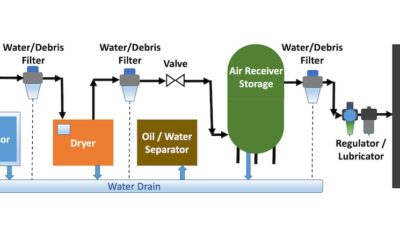Process continues to meet the intense challenges of gas, oil, water and many other industries
Piping is critical to industrial operations across all spectrums, and welding is the process that protects the integrity of the pipes. Hospitals using medical gases, oil companies transporting their products, paper mills moving processing chemicals, even athletic facilities heating their fields in extreme temperatures, rely on the dependability of pipes and their welding. The welding process has been around for centuries, and continues to meet the intense challenges of gas, oil, water and many other industries.
One of the primary benefits of welding is its flexibility. Industrial plants can weld materials in one location, ship them to the facility for installation, and position them in various configurations. Flexibility is especially valuable in the repair process, as welders can crawl up in a pipe rack in a petrochemical plant, use a torch or some other cutting process to remove the bad section and make the repair. In the transportation of fuel and natural gas, repairs are time sensitive and are even made with products flowing.
The strength of a good weld provides for vast options based on filler metal and process. It doesn’t matter the thickness or the size of the pipe, there is a welding process to join it together. With the proper engineering, you can achieve a certain hardness, toughness, flexibility or elasticity based on the environment. You can essentially make the weld stronger than the actual metal.
Engineers are not just using mild steel pipe anymore but are designing applications for higher strength alloys, heat resistant alloys and corrosion resistant alloys. Those alloy materials are expensive and difficult to machine, but there always seems to be a welding process and a filler metal developed to join them. This improved engineering helps pipes stay in service longer.
New welding inspection technology provides several different measurements to evaluate, verify and validate the integrity of the weld in less time than in the past. Welding codes, standards and methods dictate what kind of weld requirements are needed based upon its planned use and length of service. Radiographic examination, ultrasonic examination, magnetic particle examination, or visual inspection may be employed. In the past, substantial downtime occurred while inspections were done. But now there is technology, such as automated ultrasonic testing, that runs around the pipe at fast travel speeds and measures the integrity of the weld immediately. Inspections can be made with the automated process going down the line, saving time and money.
There is more control and more uniform shape on the inside of the pipe when you weld it than you would receive with mechanical joining, especially compared to fittings that would go at slants or turns. These are the spots that you usually have to repair more often because stagnant materials have caused corrosion on certain areas of the joint. If you can control the shape of the weld beads on the inside of the pipe versus some kind of mechanical or a flange or a coupling, then those pipes are going to last longer than joined using a mechanical process.
Engineers can also control how much product they want to flow through the pipe by controlling how much weld is penetrated on the inside of the pipe (the build-up). Some pipe line welders keep the weld beads flush on the inside of the pipe, so they are not losing any flow. If you have a weld bead going around every 40-ft. section of pipe that was 3/8 of an inch wide and 3/16 of an inch high, you are going to restrict the flow versus maintaining a minimum build up.
The design of new welding equipment is, of course, also changing the landscape of the industry. Robotic and semi-automatic pipe welding systems are faster and more efficient thus saving time and money. Technology is also helping with a problem caused by the aging of the welder workforce. Accomplished welders are retiring and being replaced by those without their predecessors’ skill level. New equipment is being introduced that provides more control and consistency.
Equipment like the Thermal Arc PowerMaster is centered on synergic control, otherwise know as "one knob control." The wire feed speed is linked to the arc voltage, and when an operator makes adjustments, the two are matched through the machine’s software to deliver perfect, consistent welding parameters. Among its many applications, digital welding by oil companies in deep water and cross country pipeline applications. No matter how complex a situation a welding situation may be, engineers seem to rise to the occasion.
Welding, a process that began thousands of years ago with primitive uses, has evolved into an essential aspect of all of our industrial operations. It will never be obsolete.
Dan Jones is a Technical Sales Manager for Thermadyne, a global supplier of cutting and welding products. He may be contacted at [email protected]



